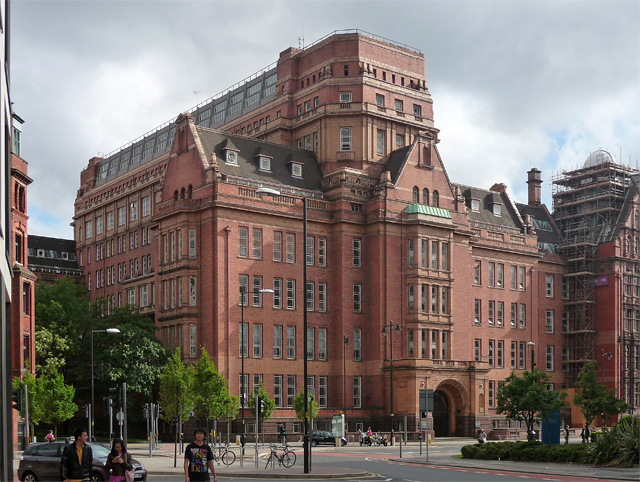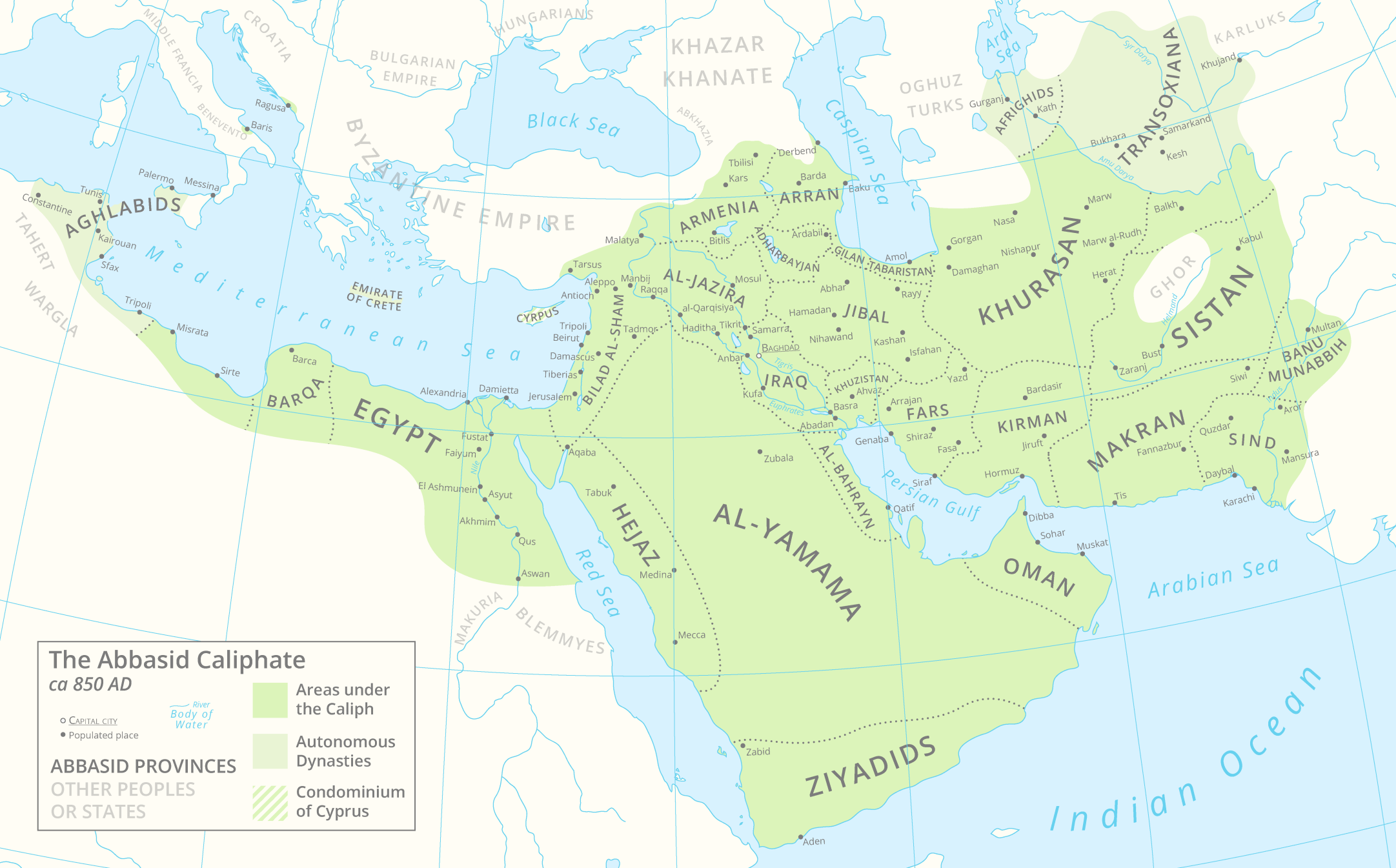|
Marwan Ibn Abi Al-Janub
Marwan ibn Abi al-Janub () (fl. 813– 861) was a 9th century poet from Abbasid Baghdad. He was also governor of Bahrayn and Yamama. Marwan al-Janub was also known as Marwan al-Aṣghar (). Background and career Marwan al-Janub was from a family of prominent poets, the most famous being his grandfather Marwan ibn Abi Hafsa (723–). Both were descendants of Abu Hafsa Yazid, a tax administrator and possible court physician who married the daughter of the amir of al-Yamama after being freed from servitude by Marwan I in 656. Al-Janub wrote panegyric poetry for Caliphs al-Ma'mun (), al-Mu'tasim (), al-Wathiq () and al-Mutawakkil (). From al-Mutawakkil, he sought political favor by composing anti-Shi'a poems. He also commemorated the day that al-Mutawakkil appointed his three sons as heirs by chanting an ode to them. Most contemporaneous and subsequent critics considered al-Janub's poetry mediocre, however little of it has survived. Al-Mutawakkil made al-Janub governor of Bahrayn ... [...More Info...] [...Related Items...] OR: [Wikipedia] [Google] [Baidu] |
Poet
A poet is a person who studies and creates poetry. Poets may describe themselves as such or be described as such by others. A poet may simply be the creator (thought, thinker, songwriter, writer, or author) who creates (composes) poems (oral tradition, oral or literature, written), or they may also performance, perform their art to an audience. The work of a poet is essentially one of communication, expressing ideas either in a literal sense (such as communicating about a specific event or place) or metaphorically. Poets have existed since prehistory, in nearly all languages, and have produced works that vary greatly in different cultures and periods. Throughout each civilization and language, poets have used various styles that have changed over time, resulting in countless poets as diverse as the literature that (since the advent of writing systems) they have produced. History Ancient poets The civilization of Sumer figures prominently in the history of early poetry, a ... [...More Info...] [...Related Items...] OR: [Wikipedia] [Google] [Baidu] |
Al-Mu'tasim
Abū Isḥāq Muḥammad ibn Hārūn al-Rashīd (; October 796 – 5 January 842), better known by his laqab, regnal name al-Muʿtaṣim biʾllāh (, ), was the eighth Abbasid Caliphate, Abbasid caliph, ruling from 833 until his death in 842. When al-Ma'mun died unexpectedly on campaign in August 833, al-Mu'tasim was thus well placed to succeed him, with the support of the powerful chief , Ahmad ibn Abi Duwad, he continued to implement the rationalist Islamic doctrine of Mu'tazilism and implementing policy. A younger son of Caliph Harun al-Rashid (r. 786–809), he rose to prominence through his formation of a private army composed predominantly of Turkic peoples, Turkic slave-soldiers (, sing. ). This proved useful to his half-brother, Caliph al-Ma'mun, who employed al-Mu'tasim and his Turkish guard to counterbalance other powerful interest groups in the state, as well as employing them in campaigns against rebels and the Byzantine Empire under the Amorian dynasty, Byzantine ... [...More Info...] [...Related Items...] OR: [Wikipedia] [Google] [Baidu] |
9th-century People From The Abbasid Caliphate
The 9th century was a period from 801 (represented by the Roman numerals DCCCI) through 900 (CM) in accordance with the Julian calendar. The Carolingian Renaissance and the Viking raids occurred within this period. In the Middle East, the House of Wisdom was founded in Abbasid Baghdad, attracting many scholars to the city. The field of algebra was founded by the Muslim polymath al-Khwarizmi. The most famous Islamic scholar Ahmad ibn Hanbal was tortured and imprisoned by Abbasid official Ahmad ibn Abi Du'ad during the reign of Abbasid caliph al-Mu'tasim and caliph al-Wathiq. In Southeast Asia, the height of the Mataram Kingdom happened in this century, while Burma would see the establishment of the major kingdom of Pagan. Tang China started the century with the effective rule under Emperor Xianzong and ended the century with the Huang Chao rebellions. In America, the Maya experienced widespread political collapse in the central Maya region, resulting in internecine warf ... [...More Info...] [...Related Items...] OR: [Wikipedia] [Google] [Baidu] |
9th-century Arab People
The 9th century was a period from 801 (represented by the Roman numerals DCCCI) through 900 (CM) in accordance with the Julian calendar. The Carolingian Renaissance and the Viking raids occurred within this period. In the Middle East, the House of Wisdom was founded in Abbasid Caliphate, Abbasid Baghdad, attracting many scholars to the city. The field of algebra was founded by the Muslim polymath al-Khwarizmi. The most famous Islamic scholar Ahmad ibn Hanbal was tortured and Imprisonment, imprisoned by Abbasid official Ahmad ibn Abi Du'ad during the reign of Abbasid caliph al-Mu'tasim and caliph al-Wathiq. In Southeast Asia, the height of the Mataram Kingdom happened in this century, while Burma would see the establishment of the major kingdom of Pagan Kingdom, Pagan. Tang china, Tang China started the century with the effective rule under Emperor Xianzong of Tang, Emperor Xianzong and ended the century with the Huang Chao#Rebellions, Huang Chao rebellions. In America, the Maya ... [...More Info...] [...Related Items...] OR: [Wikipedia] [Google] [Baidu] |
Indiana University
Indiana University (IU) is a state university system, system of Public university, public universities in the U.S. state of Indiana. The system has two core campuses, five regional campuses, and two regional centers under the administration of IU Indianapolis. The flagship campus of Indiana University is Indiana University Bloomington. Campuses Core campuses *Indiana University Bloomington (IU Bloomington) is the flagship campus of Indiana University. The Bloomington campus is home to numerous premier Indiana University schools, including the College of Arts and Sciences, the Hutton Honors College, the Jacobs School of Music, an extension of the Indiana University School of Medicine, the Indiana University School of Informatics, Luddy School of Informatics, Computing, and Engineering, which includes the former School of Library and Information Science (now Department of Library and Information Science), School of Optometry, the Indiana University School of Public and Enviro ... [...More Info...] [...Related Items...] OR: [Wikipedia] [Google] [Baidu] |
University Of Manchester
The University of Manchester is a public university, public research university in Manchester, England. The main campus is south of Manchester city centre, Manchester City Centre on Wilmslow Road, Oxford Road. The University of Manchester is considered a red brick university, a product of the civic university movement of the late 19th century. The current University of Manchester was formed in 2004 following the merger of the University of Manchester Institute of Science and Technology (UMIST) and the Victoria University of Manchester. This followed a century of the two institutions working closely with one another. Additionally, the university owns and operates major cultural assets such as the Manchester Museum, The Whitworth art gallery, the John Rylands Library, the Tabley House, Tabley House Collection and the Jodrell Bank Observatory – a UNESCO World Heritage Site. The University of Manchester Institute of Science and Technology had its origins in the Manchester Mechan ... [...More Info...] [...Related Items...] OR: [Wikipedia] [Google] [Baidu] |
Al-Muntasir
Abu Ja'far Muḥammad ibn Ja'far ibn Muḥammad ibn Hārūn al-Muntasir biʾLlāh (; November 837 – 7 June 862), better known by his regnal title al-Muntasir biʾLlāh (, "He who triumphs in God") was the caliph of the Abbasid Caliphate from 861 to 862, during the "Anarchy at Samarra". The power struggle between al-Muntasir and his brother, al-Mu'tazz, backed by different factions, climaxed with the Turkic leaders plotting the murder of his father al-Mutawakkil. Following the assassination in 861, al-Muntasir assumed the caliphate with Turkic support. His reign, lasting only six months, saw a shift in policies, including a more favorable stance towards the House of ʻAlī and the lifting of the ban on pilgrimage to the tombs of Hassan and Hussayn. Al-Muntasir engaged in military actions against the Byzantines, led by his general Wasif al-Turki, but his sudden death in June 862 resulted in a change of leadership, and al-Musta'in succeeded him as caliph. The military campaign ... [...More Info...] [...Related Items...] OR: [Wikipedia] [Google] [Baidu] |
Shia Islam
Shia Islam is the second-largest Islamic schools and branches, branch of Islam. It holds that Muhammad in Islam, Muhammad designated Ali ibn Abi Talib () as both his political Succession to Muhammad, successor (caliph) and as the spiritual leader of the Muslim community (Imamah (Shia doctrine), imam). However, his right is understood to have been usurped by a number of Companions of the Prophet, Muhammad's companions at the meeting of Saqifa where they appointed Abu Bakr () as caliph instead. As such, Sunni Muslims believe Abu Bakr, Umar (), Uthman () and Ali to be 'Rashidun, rightly-guided caliphs' whereas Shia Muslims only regard Ali as the legitimate successor. Shia Muslims assert imamate continued through Ali's sons Hasan ibn Ali, Hasan and Husayn ibn Ali, Husayn, after whom different Shia branches have their own imams. They revere the , the family of Muhammad, maintaining that they possess divine knowledge. Shia holy sites include the Imam Ali Shrine, shrine of Ali in Naj ... [...More Info...] [...Related Items...] OR: [Wikipedia] [Google] [Baidu] |
Al-Mutawakkil
Ja'far ibn al-Mu'tasim, Muḥammad ibn Harun al-Rashid, Hārūn al-Mutawakkil ʿalā Allāh (); March 82211 December 861, commonly known by his laqab, regnal name al-Mutawwakil ala Allah (), was the tenth Abbasid Caliphate, Abbasid caliph, ruling from 847 until his assassination in 861. He succeeded his brother, al-Wathiq (), and is known for expanding the empire to its maximum extent. He was deeply religious, and is remembered for discarding the Muʿtazila, ending the Mihna (a period of persecution of Islamic scholars), and releasing Ahmad ibn Hanbal. He is also known for his tough rule, especially with respect to non-Muslim subjects. He was assassinated on 11 December 861 by the Turkic guard with the support of his son, al-Muntasir, marking the beginning of the period of civil strife known as the "Anarchy at Samarra". Early life Al-Mutawakkil was born on 31 March 822 to the Abbasid prince Abu Ishaq Muhammad (the future al-Mu'tasim) and a slave concubine from Khwarazm named S ... [...More Info...] [...Related Items...] OR: [Wikipedia] [Google] [Baidu] |
Al-Wathiq
Abū Jaʿfar Hārūn ibn Muḥammad al-Wathiq bi'Llah (; 18 April 81210 August 847), commonly known by his regnal name al-Wathiq bi'Llah (), was an Abbasid caliph who reigned from 842 until his death in 847. Al-Wathiq is described in the sources as well-educated, intellectually curious, but also a poet, who enjoyed the company of poets and musicians as well as scholars. His brief reign was one of continuity with the policies of his father, al-Mu'tasim (), as power continued to rest in the hands of the same officials whom al-Mu'tasim had appointed. The chief events of the reign were the suppression of revolts: Bedouin rebellions occurred in Syria in 842, the Hejaz in 845, and the Yamama in 846, Armenia had to be pacified over several years, and above all, an abortive uprising took place in Baghdad itself in 846, under Ahmad ibn Nasr al-Khuza'i. The latter was linked to al-Wathiq's continued support for the doctrine of Mu'tazilism, and his reactivation of the to root out oppo ... [...More Info...] [...Related Items...] OR: [Wikipedia] [Google] [Baidu] |
Al-Ma'mun
Abū al-ʿAbbās Abd Allāh ibn Hārūn al-Maʾmūn (; 14 September 786 – 9 August 833), better known by his regnal name al-Ma'mun (), was the seventh Abbasid caliph, who reigned from 813 until his death in 833. His leadership was marked by the power and prosperity of the Abbasid Caliphate, al-Ma'mun promoted the Graeco-Arabic translation movement, the House of Wisdom, flowering of learning and the sciences in Baghdad, and the publishing of al-Khwarizmi's The Compendious Book on Calculation by Completion and Balancing, book now known as "Algebra". Making him one of the most important caliphs in the Islamic Golden Age. He is also known as a proponent of the rational Islamic theology of Mu'tazilism. Al-Ma'mun succeeded his half-brother al-Amin after a Fourth Fitna, civil war, much of his reign was spent on peace campaigns. His strong support for Mu'tazilism led him to imprison a Sunni Islam, Sunni Imam, Ahmad ibn Hanbal in an event that became known as ''mihna.'' Al-Ma'mun's for ... [...More Info...] [...Related Items...] OR: [Wikipedia] [Google] [Baidu] |
Abbasid
The Abbasid Caliphate or Abbasid Empire (; ) was the third caliphate to succeed the prophets and messengers in Islam, Islamic prophet Muhammad. It was founded by a dynasty descended from Muhammad's uncle, Abbas ibn Abd al-Muttalib (566–653 Common Era, CE), from whom the Abbasid dynasty, dynasty takes its name. After overthrowing the Umayyad Caliphate in the Abbasid Revolution of 750 CE (132 anno Hegirae, AH), they ruled as caliphs based in modern-day Iraq, with Baghdad being their capital for most of their history. The Abbasid Revolution had its origins and first successes in the easterly region of Greater Khorasan, Khurasan, far from the Levantine center of Umayyad influence. The Abbasid Caliphate first centered its government in Kufa, modern-day Iraq, but in 762 the caliph al-Mansur founded the city of Baghdad as the new capital. Baghdad became the center of Science in the medieval Islamic world, science, Islamic culture, culture, Abbasid art, arts, and List of invent ... [...More Info...] [...Related Items...] OR: [Wikipedia] [Google] [Baidu] |









